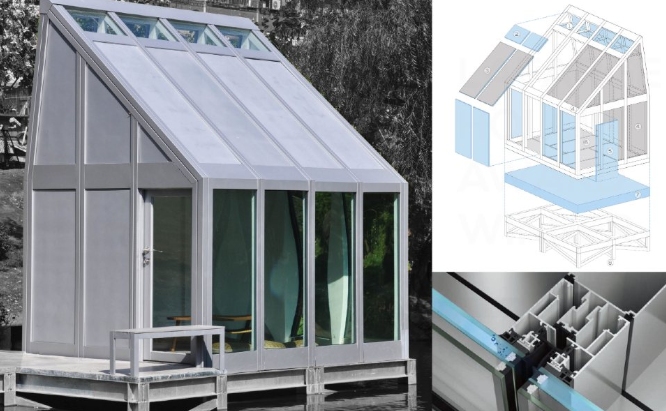A heating system using water-filled glazing could offer huge energy savings over more traditional approaches, according to the academic who devised the concept.
Loughborough University’s Dr Matyas Gutai says the system offers energy savings of up to 72% when compared to buildings with conventional heating and double glazing.
Gutai, who has been studying water-filled glass for a decade and has created two ‘water houses’ in Hungary and Tokyo, has developed the system using water to heat and cool structures.
The water-filled glass (WFG) system works by connecting the water-filled window panels to a storage tank using pipes hidden in the walls, so fluid can circulate between the two. This system allows the ‘water houses’ to cool and reheat themselves, without needing an additional energy supply for most of the year.
When it is warm, the buildings stay cool as the water absorbs external and internal heat; this warm water is then circulated to the storage tank– which can either be in the foundations or placed somewhere in the building. The heat is stored in the tank and, if the temperature drops, it can be brought back to the walls to reheat the building using a monitoring system similar to central heating. Alternatively, the stored heat can be used for hot water supply.
Dr Gutai’s latest study, published in Elsevier’s Energy and Buildings Journal in collaboration with Dr Abolfazl Kheybari, of the University of Kaiserslautern, demonstrates how WFG can “revolutionise” building design and performance when used as part of a wider heating system.
Dr Gutai’s inspiration came from the fact that the insulation capacity of windows is considerably worse than a normal wall surface and small changes can lead to up to 25% energy savings for the whole building. He developed the concept while studying for a PhD at the University of Tokyo after being inspired by Japanese outdoor baths – known as ‘rotenburo’ – which are used also during the winter as the water’s thermal properties keep people warm.

His latest research claimed that water-filled glass systems perform well in any inhabited climate – keeping buildings in hot climates cool, and buildings in cool settings warm – without requiring an additional energy supply, highlighting the technology’s potential to make a real splash when it comes to reducing carbon emissions.
He is now looking to develop the product commercially.
Other claimed benefits include improved acoustics, less need of ‘shading’, and no need to colour the glass to improve energy efficiency.
Dr Gutai said: “Glass is currently a liability in buildings as it compromises energy consumption, thermal comfort, acoustics and other aspects.
“WFG changes this paradigm and turns glass into an opportunity for sustainable construction.
“It shows us that thinking holistically about buildings and building components leads to a more efficient and sustainable built environment.
“In case of a window for example, if we see it as an isolated system, solar overheating is a challenge that needs to be remedied with cooling.
“If we approach this holistically, the heat surplus is an opportunity because the same heat is missing from somewhere else (i.e. colder part of the building or hot water supply).”
Comments
Comments are closed.











And in a Scottish winter…..what happens then? Will it freeze and shatter the glass? Asking for a friend.
very interesting will be pleased to receive any tech info for house building project
thank you
We need to go green now using the sun to our advantage for heating and cooling the government needs to do more to pursue this and it would also assure that people don’t go cold in the winter and stay cool in summer and we can protect our planet by using other planets to do so ,its a simple solution.
I assume this work builds on Frederick McKee’s decades of work on Fluidized Glazing and trust his pioneering development is acknowledged. I commended his work, and introduced him, to major players in the glazing industry; the response reflected vested interests, and is well worth bearing in mind.